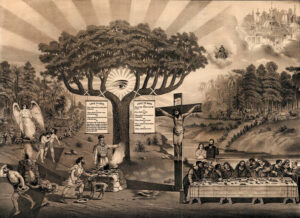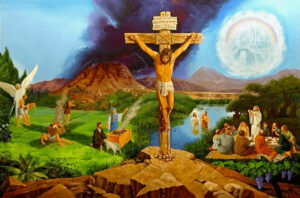
Key to the Allegorical Engraving Entitled
“CHRIST, the WAY OF LIFE “
(Battle Creek 1884, Condensed, 1980)
1. As a work of art, it commends itself to all lovers of the beautiful… It’s skillful grouping and it’s harmonious combination of light and shade…delight the cultivated taste, and suggest abundant food for thought. The conception of the picture…has never been satisfactory until it was brought out in steel by one of the best artists in the country, resulting in the beautiful engraving under consideration.
2. The Theme. “The Way of Life from Paradise Lost to Paradise Restored.” The picture presents, at one view, the history…of man as related to the plan of salvation, from the first transgression to the close of probation, and the restoration of the race to it’s Edenic holiness… It’s central purpose is the
EXALTATION OF THE CROSS
The death of the Son of God is given prominence as the great event in the plan of human redemption. In the light of this grand scene, all other events in the history of the race pale into insignificance. Around it cluster the hopes of humanity, and upon it hangs the destiny of the soul. Worthy of the first and best thoughts of writer or artist, it occupies the foreground of the picture, as the grand pivotal thought of the scenic composition before us.
Taking our position at the foot of the cross, we look backward in the history of man, and trace the steps which have led upward to the scenes of Calvary. The scenes which suggest the provision of the gospel are enacted
IN THE SHADOW OF THE CROSS
Which is cast far back over the history of the race, reaching even to the gates of Eden…The shadow…inspires faith and hope…
At the extreme left of the picture is presented a view of the
EXPULSION OF OUR FIRST PARENTS FROM EDEN
Driven from the abode of their former innocence, in sorrow, shame, and distress, with the wrath of God hanging over them, represented by the angry clouds and the vivid lightning, they step into the shadow of the cross…
THE SACRIFICIAL OFFERINGS
Coming down the stream of time, we have…the sacrifice offered by Abel, who presented a lamb, which shadowed forth the death of Christ…
THE FAULT IN THE SACRIFICE OF CAIN
The failure of Cain to exercise faith in Christ is attested by the fact that his sacrifice was devoid of blood, or life, and by his anger at the acceptance of Abel’s sacrifice and the rejection of his own…He slays his brother, who falls in the shadow of the cross…
THE TYPES AND SHADOWS
Coming yet nearer the cross,…we find the system of types and shadows which…exemplify an active faith in the gospel…We here have the penitent, confessing his sins on the head of the victim, showing his faith in the transfer of his sins to Christ by confession, in this figurative transfer to the typical offering. Realizing that the immutable law of God demands the life of its transgressor, he thus shows his faith in the promise of Christ to take upon Himself the sins of His people, and bear them “in His own body on the tree” (1 Peter 2:24).
THE WORK OF THE PRIESTHOOD
We have, also, the advocacy of the priest, who, in behalf of the sinner, points to the offered sacrifice with one hannd, and forward to the cross with the other…This also suggests the additional office of Christ as a priest…and connects the earthly sanctuary with the heavenly, from which, as Paul states in Hebrews 9:23, the sins of the people are purged “with better sacrifices” than the blood of bulls and goats, viz., that of the Son of God Himself.
Reaching the foot of the cross, the shadow ceases. We come now to the
SUBSTANCE WHICH CAST THE SHADOW
Or, in other words, the event toward which the types and shadows pointed. These all ceased at the cross…
DECLINE OF PAGANISM
In the middle distance of the picture are seen the ruins of pagan temples and relics of heathenism, showing the decline of false religions before the true…
GOSPEL MEMORIALS
At the right of the cross the scene changes. No longer in the dispensation of types and shadows, we have in their stead the memorials of the Gospel, baptism and the Lord’s supper…
They are placed at the right of the cross, in the picture, as showing their purpose in the Christian dispensation. The ordinance of baptism, performed once for the believer, at the death of the “old man” of sin, and his “putting on the new man,” shows his death, burial, and resurrection of Christ. The Lord’s supper, to be celebrated at frequent intervals in the church, is emblematical of the broken body and spilled blood of the Divine Sacrifice for man; by which, “as often” as it is observed, the believer shows “the Lords death till He come” (1 Cor. 11:26)
WITH THAT COMING
is the glorious consummation which the artist has endeavored to present in the upper right hand corner of the picture. “In my Father’s house,” said the Saviour, “are many mansions.” “I go to prepare a place for you; and if I go and prepare a place for you, I will come again, and recieve you unto myself, that where I am, there ye may be also.” Glorious promise! Paradise regained! The “many mansions” glistened in the light of the heavenly glory.
Looking back over the journey already trod, the “redeemed of Zion” esteem all their trials as but “light afflictions” in view of the “eternal weight of glory” to be realized in PARADISE RESTORED.
History of the Way of Life Pictures

The first version was designed and copyrighted in 1873 by Dr. Merritt Gardner Kellogg, the older half-brother of Dr. John Harvey Kellogg and Will Keith Kellogg. It was titled “The Way of Life: From Paradise Lost to Paradise Restored,” and advertised for one dollar on page 192 in the Advent Review and Herald of the Sabbath – May 27, 1873. The picture was an immediate success and proved to be a great aid to Adventist evangelists in their efforts to present the relationship between the law and the gospel.
James White first mentions this picture in a letter written on January 2, 1873, to his sons, Edson and Willie: “I wrote all about the Way of Life chart.” Later, Ellen White wrote to her son, Willie:
Yesterday morning a very interesting woman came to buy the picture of The Way of Life and Testimony #23. Said she was converted from a staunch Catholic through my labors here [Santa Rosa, California] last year… Said she, “It seemed to me God sent you as an angel from heaven to show me my error and superstitious faith. Now I can.” said she, “rejoice in the truth.” –Letter 10, 1874, February 10, 1874
Three years later it was decided to improve the picture, and to get out a descriptive brochure to accompany it. James White wrote to his wife on April 7, 1876:
I go to New York in May to get out Way of Life and charts…Tell Willie that I begin my book on Way of Life next week, and will let him have it for Signs, piece by piece.
Five days later, James White wrote that he was planning to leave in a few days for New York “and start the charts and Way of Life” (James White, April 12, 1876).

In July of that same year Ellen White wrote from New Jersey:
The Way of Life is to be revised and improved in every way. The charts are to be considered and our pictures for books are to be engraved in New York. There is enough to consider and plan and arrange and we hope to do this all with exactitude which will leave us no chance for regret…
The designs of Way of Life are now to be presented to the artist, also Law of God charts. This is a large business being carried on by Father just now in Philadelphia. –Letter 35, 1876, July 30, 1876.
James White’s Letters written during the remainder of that year indicate that much thought and planning were going into the Way of Life. He was planning to get Way of Life lithographed “immediately.” But he needed money, and wrote to Willie on July 19 that he must have $1,000, “if you can spare it.” Willie, at Pacific Press, was expected to “meet those expenses from sales of paper” (James White, July 18-19, 1876). Finally, on October 26, 1876, he wrote to Willie, “One thousand Way of Life is on the way.”
Four years later, Elder White began planning to change the emphasis in the picture. He wrote to his wife:

I have a sketch also of the new picture, “Behold the Lamb of God.” This differs from the Way of Life in these particulars: The Law Tree is removed. Christ on the cross is made large, and placed in the center. In other particulars it is about the same excepting the baptism scene and the city will be very much improve. — James White, March 31, 1880.
And to his son, W.C.White, he sent the following instructions:
I am getting a very much improved engraving, which will kill the old one; those on hand should be disposed of…Write me immediately and state how many copies of the Way of Life there are in the office. –James White, undated, 1880
By this time Elder White’s plans had expanded to include printing the picture for use in other countries. In January, 1881, he went to New York City “to see Thomas Moran who is said to be the best artist in the world, in reference to the completion of steel engraving of Way of Life. It will cost me $1,100 to get the plate…It will sell for $1.25″ (James White, January 19, 1881).
Further inspired with the power of the picture, James White next planned to publish a book to accompany it, enlarging the Key, or explanation, already in print. He would title it, Christ the Way of Life. From Paradise Lost to Paradise Restored. But this ambition was not fulfilled in his lifetime. He died on August 6, 1881. With the help of her sons, Ellen White undertook to fulfill her husband’s plan, and in 1883, a beautiful new steel plate engraving was copyrighted by Ellen White which placed Christ at the center of the plan of salvation.

In the spring of 1980, the staff of the Ellen G. White Estate commissioned Adventist artist Elfred Lee to render the Way of Life picture yet again. Working in the Auburn, California, church, Mr. Lee created a mural seven feet tall and ten feet long, which became the centerpiece of the White Estate display at the 1980 General Conference Session in Dallas, Texas.
After the session, the mural went on permanent display in the Ellen G. White Estate offices at the General Conference in Washington, D.C. In 1989 it was moved to the new headquarters building in Silver Spring, Maryland, where thousands of visitors enjoy its striking beauty and take in its spiritual lessons.
Additional References
- 1873 Key by James White
- Way of Life – Adventist Review
- Way of Life – Ministry Magazine
